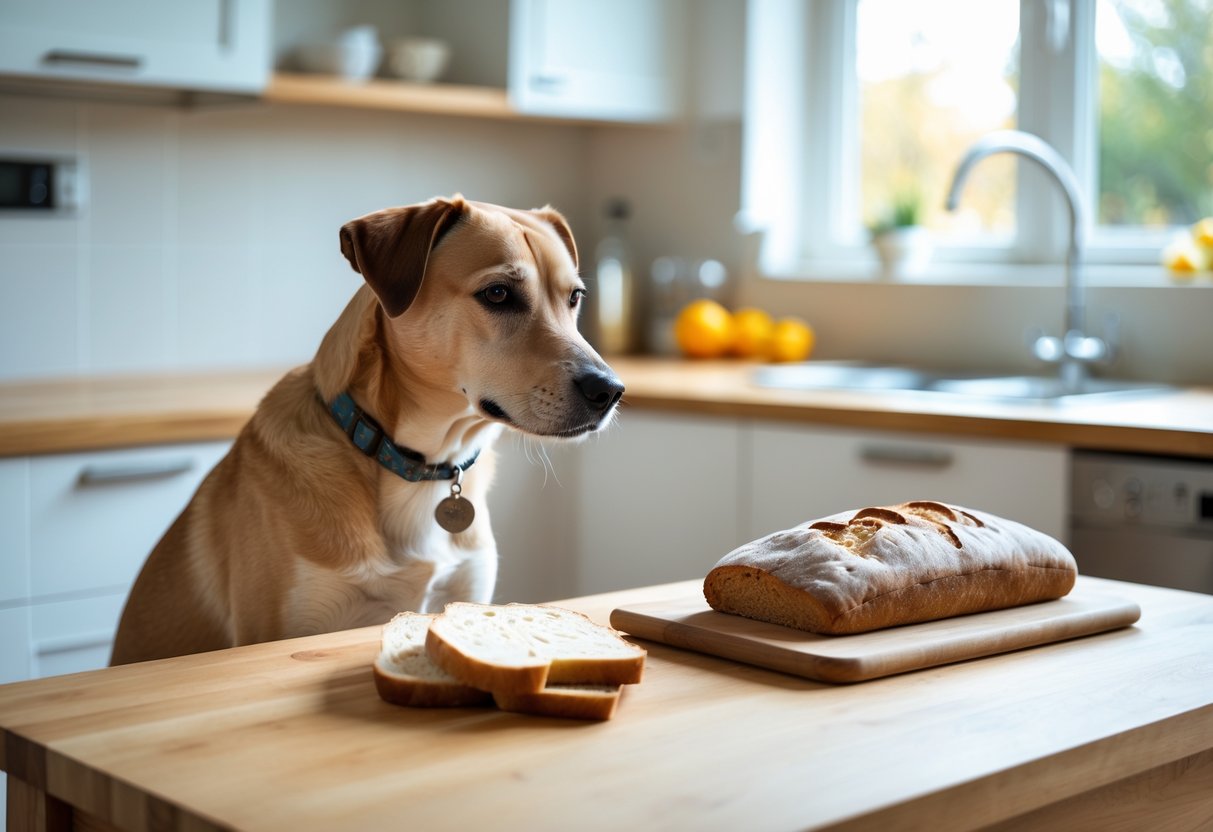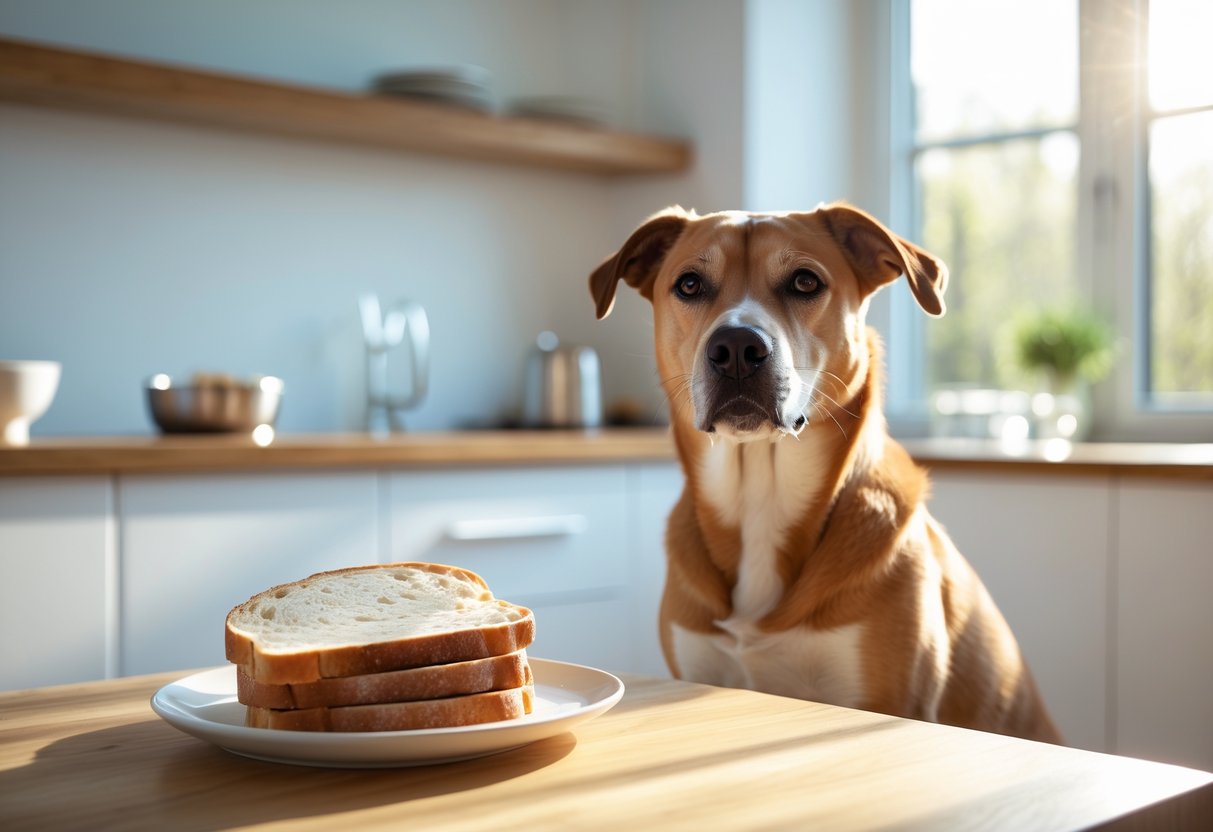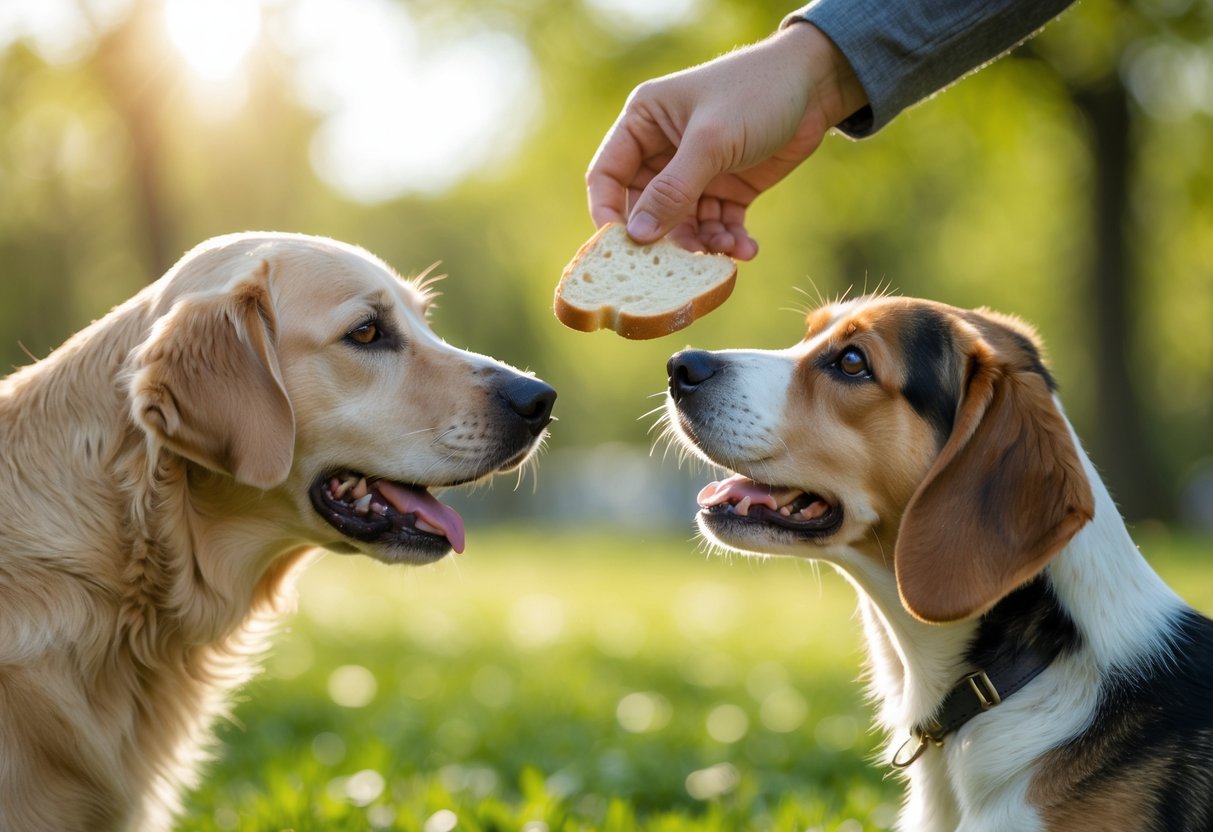Ever catch yourself wondering if it’s okay to give your dog a bit of bread? You’re definitely not the only one. The short answer: plain bread is usually safe for dogs in small amounts, but it doesn’t really benefit their health and should just be an occasional treat.

Bread is tempting to share, especially at mealtimes. But not every loaf is safe for dogs.
Some breads sneak in ingredients like garlic, seeds, or dried fruits, and those can be risky for your pup. Figuring out what to avoid and how to offer bread safely can make all the difference for your dog’s health.
Key Takeways
- Plain bread is safe for dogs in moderation but has no nutritional value.
- Avoid breads with harmful ingredients like garlic or seeds.
- Knowing what and how to feed bread can protect your dog’s health.
Can Dogs Eat Bread? Risks and Benefits
Bread might seem like an easy treat to share, but you need to think before handing it over. The type of bread and its ingredients matter more than you’d expect.
Is Bread Safe for Dogs?
Most dogs can have a bite or two of plain white or whole wheat bread. As long as there aren’t extras like raisins or garlic, it’s generally fine.
Bread doesn’t really offer much nutrition for dogs. It’s mostly carbs, and dogs don’t need much of that. Too much can lead to weight gain.
Never, ever give your dog raw bread dough. Yeast in the dough can cause bloating and even alcohol poisoning. Only share fully baked bread, and always check for toxic ingredients.
Potential Health Benefits
Bread isn’t a superfood for dogs, but it does have a little protein, carbs, and some fibre. Whole wheat bread has more fibre than white, which may help with digestion.
Sometimes, a small piece of plain bread gives a quick energy boost. It’s also soft and easy to use as a treat during training.
Health Risks and Hazards
Letting your dog eat bread too often or in large amounts can lead to weight gain and obesity. That opens the door to diabetes and joint trouble.
Some breads hide dangerous ingredients like raisins, garlic, onion, or sweeteners like xylitol. These can seriously harm your dog—avoid them at all costs.
Too much bread can also upset your dog’s stomach, causing vomiting, diarrhoea, or bloating. If you notice any of these after your dog eats bread, call your vet.
Types of Bread: Safe vs Unsafe
Here’s a quick guide to bread types:
| Bread Type | Safe for Dogs? | Notes |
|---|---|---|
| Plain White Bread | Yes | Safe in small amounts, low nutritional value |
| Whole Wheat Bread | Yes | Higher fibre but check for additives |
| Multigrain & Seeded | No | Seeds and nuts can be harmful |
| Bread with Raisins | No | Raisins are toxic |
| Garlic or Onion Bread | No | Both garlic and onion are toxic |
| Sweet Breads (e.g. Brioche) | Caution | High fat and sugar; feed sparingly |
| Gluten-Free Bread | Caution | Check for artificial sweeteners like xylitol |
| Toasted Bread | Yes | Plain toasted bread is safe, avoid burnt or buttered |
Stick with plain bread in moderation. If you’re unsure, simple is always safer, and keep an eye out for any weird reactions.
For more details, check out Canine Bible’s guide on bread for dogs.
Feeding Bread to Dogs: Practical Guidance
If you’re going to give your dog bread, pay close attention to the amount and ingredients. And if your dog somehow gets into raw dough, you need to act fast.
How Much Bread Can Dogs Eat?
Bread should always be just a treat, never a main part of your dog’s diet. All treats, bread included, shouldn’t be more than 10% of their daily food.
Here’s a rough guide for serving size by dog size:
| Dog Size | Serving Size |
|---|---|
| Extra-small (2-15 lbs) | ¼ to ½ slice of plain bread |
| Small (16-25 lbs) | ½ slice of plain bread |
| Medium (26-60 lbs) | ½ to 1 slice of plain bread |
| Large (61-90 lbs) | 1 slice of plain bread |
| Extra-large (91+ lbs) | Up to 1½ slices split over time |
Start with a little and see how your dog handles it. Too much bread can bring on weight gain or tummy troubles.
Whole Wheat vs White Bread
White and whole wheat bread are both okay in small amounts. Each has its pros and cons.
White bread is lower in fibre and sometimes easier on sensitive stomachs. Whole wheat has more fibre, which can help digestion but might not suit every dog.
Always read the label for hidden sugars, salt, or odd ingredients. The plainer, the better—skip fancy flavors or seeds.
If your dog has allergies or a sensitive belly, you might want to skip whole wheat.
Unsafe Ingredients and Additives
Some breads hide things that are bad for dogs. Here’s what to watch for:
- Raisins and sultanas (toxic to dogs)
- Garlic and onion (can cause blood problems)
- Nuts and seeds (some are toxic or cause choking)
- Xylitol or artificial sweeteners (very dangerous)
- Chocolate or sugar (unhealthy and toxic in large amounts)
Serve bread plain—no butter, oil, or spices. If you’re unsure, double-check the label. Better safe than sorry, right?
What to Do If Your Dog Eats Raw Dough
Raw bread dough is a big no for dogs. Yeast in the dough can expand in their stomach and release alcohol.
This swelling (bloating) is painful and can be deadly. The alcohol from fermentation can also poison your dog.
If you think your dog ate raw dough, look out for vomiting, bloating, weakness, or acting confused. Call your vet right away.
Keep your dog calm, and don’t give them food or water until you’ve spoken to a professional. Acting quickly can make a huge difference.
For more on safe feeding, check this guide on feeding bread to dogs.
Frequently Asked Questions
Still got questions about bread and dogs? You’re not alone. Here are some of the things dog owners ask most often.
Is it safe to give my dog toast for breakfast?
Plain toast—no butter or toppings—is usually fine in small amounts. Don’t give burnt or greasy toast; burnt bits can upset their stomach, and too much fat isn’t good for dogs.
How often can our fur babies enjoy a slice of bread?
Bread should be a rare treat. Try to keep it under 10% of your dog’s daily calories to avoid weight gain and health issues.
Should I be worried if my pup snatches some bread and butter?
Butter is fatty and can lead to stomach trouble or even pancreatitis if your dog eats a lot. One tiny lick probably won’t hurt, but it’s best not to make a habit of it.
What are the consequences of feeding my dog bread with cheese?
Cheese is rich and tough for some dogs to digest, which could mean an upset stomach or diarrhoea. A little probably won’t cause issues, but don’t go overboard with cheesy bread.
Can offering bread help soothe my dog’s tummy troubles?
Sometimes, plain bread can help with mild stomach irritation by adding bulk and easing nausea. But always check with your vet first, especially if symptoms stick around or get worse.
Are there any types of bread that are off-limits for dogs?
Yeah, some breads are just plain toxic for dogs. Steer clear of anything with raisins, garlic, onion, nuts, seeds, chocolate, or artificial sweeteners like xylitol.
Those ingredients can seriously harm your dog. If you want a full list, check out more about safe and unsafe bread types.



